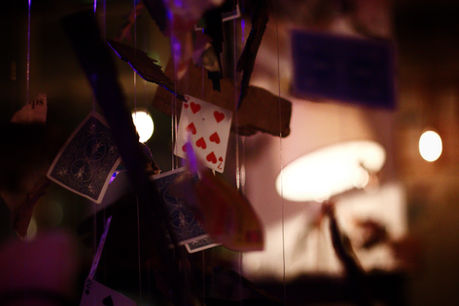
Soundscape :
Same Sh*t, Different Year
Interactive Exhibit Design - Lighting
This interactive exhibit was the first of its kind at UNC School of the Arts. When I was brought onto the project, the creative team was realizing that we would need to revisit the original concept and rework the idea from the ground up, because it just wasn't working. For me, this is the most exciting challenge as a creative who works collaboratively- Reimagining an idea and implementing your findings in a quick and effective manner.
My main roles on this project consisted of being a project manager, lighting designer, lighting system integrator, and preparing concept packages for both internal team review and external project funding approval.
Created By:
Technical Development
Interactive show control systems
We knew from the start that Soundscape was to be a high-interactivity experience where guests had the ability to influence the installation's environment and participate in the construction of a non-linear storyline. Our main focus was on creating an experience that showcased sound (hence the name).
My mind turned to thinking of ways in which I could implement a lighting system that responded not just to triggers for our lighting system but was actively communicating with sound's show control system. For example, if a guest interacted with a lamp switch trigger, it could be paralleled by an audio cue, and similarly, if a guest interacted with a rotary phone trigger, the audio could be complemented by a visual lighting cue. This of course is simplifying a much larger, tangled web of trigger connection points!
In the early technical planning stages, we had planned to use Qsys, but that was later switched to Qlab. Much of our technical development was taking place parallel to creative development, which meant that changes were to be expected and planned for. In the long run, programming was aided by the system control switch, as it accepted OSC commands much more willingly, and made remote start-up, shut down, and monitering of both the lighting and sound systems possible.
Creative Development
Supporting the concept through lighting
As mentioned previously, I entered into the creative team at a stage of redevelopment. We made our way through roughly two other concepts before reaching a stable foundation to build upon. Using my experience in building pitch decks, I was able to compliment the process by creating packages that synthesized much of the information discussed on a day-to-day basis. These packages would ultimately be developed further to present plans and budgets to the administrative department of Design and Production for funding allocation.
My background in studying both lighting design and technology allowed me to act as a bridge between the creative development teams and the technical development teams, both of which I was involved with. I was able to approach ideas from both angles and make design decisions that could be implemented effectively.
Since creative and technical development was happening simultaneously, it was paramount that I made sure my work as a lighting designer filled the cracks like glue, rather than being a new obstacle to incorporate.
When it came time for the installation of the exhibit, I brought my skills as a system integrator, theatrical technician, and sculptural artist with me to space every day.
Not only were we creating an interactive experience for guests to play with, but something sculptural that was going to be examined from every angle, by a wide variety of guests from different backgrounds. From highly experienced artists to guests with possibly no exposure to the arts whatsoever who just saw the exhibit from the sidewalk and came in. We were creating an experience that everyone could engage with.
It's this type of work where I tend to define my "position" as being a multi-disciplinary artist, because I'm no longer confined to my bubble of just lighting design or just creative direction, but I'm interacting with the space, and my fingerprint is embedded into the sculpture of it. I'm placing the lighting equipment and wiring the system, but I'm also under a table installing electrical components and helping the show set decorators set wire points for their work while I'm down there.
The installation had its own unique process but gives a large amount of credit to exhibits like "MeowWolf" for such valuable inspiration. Collaboration in this way allowed us as a creative team to create a living work of art that hopefully will serve as an inspiration for future creators.
Exhibition Photography
Photography by Jake Frizzelle















































